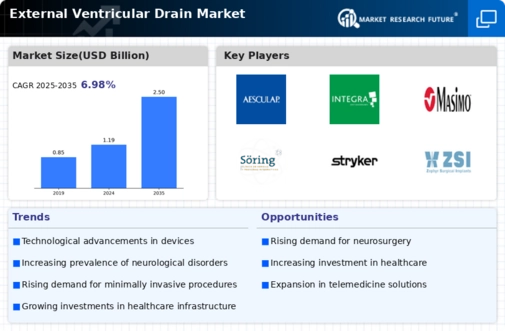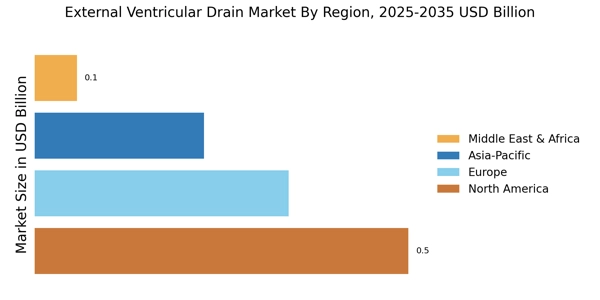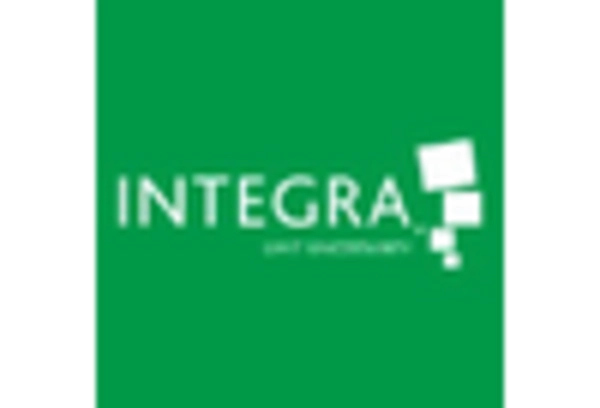Rising Incidence of Neurological Disorders
The External Ventricular Drain Market is significantly influenced by the rising incidence of neurological disorders, including traumatic brain injuries and hydrocephalus. As the global population ages, the prevalence of these conditions is expected to increase, thereby driving demand for effective treatment options. Data suggests that the number of individuals diagnosed with hydrocephalus is on the rise, with estimates indicating that approximately 1 in 1,000 live births are affected. This growing patient population necessitates the use of external ventricular drains for managing intracranial pressure, thereby propelling market growth. Healthcare providers are increasingly recognizing the importance of timely intervention, which further underscores the relevance of the External Ventricular Drain Market in contemporary medical practice.
Technological Advancements in Drainage Systems
The External Ventricular Drain Market is experiencing a surge in technological advancements that enhance the efficacy and safety of drainage systems. Innovations such as smart drainage systems equipped with sensors for real-time monitoring are becoming increasingly prevalent. These systems can provide critical data on intracranial pressure, allowing for timely interventions. Furthermore, the integration of telemedicine capabilities into these devices facilitates remote monitoring, which is particularly beneficial in critical care settings. According to recent data, the market for advanced drainage systems is projected to grow at a compound annual growth rate of approximately 7% over the next five years. This growth is indicative of the increasing reliance on technology to improve patient outcomes in neurosurgical procedures.
Increased Investment in Healthcare Infrastructure
The External Ventricular Drain Market is benefiting from increased investment in healthcare infrastructure across various regions. Governments and private entities are allocating substantial resources to enhance healthcare facilities, particularly in neurosurgery departments. This investment is aimed at improving patient care and expanding access to advanced medical technologies. For instance, the establishment of specialized neurosurgical centers is becoming more common, which directly correlates with the demand for external ventricular drains. Market data indicates that healthcare expenditure is projected to rise by approximately 5% annually, creating a favorable environment for the growth of the External Ventricular Drain Market. Enhanced infrastructure not only facilitates the adoption of innovative drainage systems but also improves overall patient outcomes.
Emergence of Minimally Invasive Surgical Techniques
The External Ventricular Drain Market is witnessing a shift towards minimally invasive surgical techniques, which are becoming increasingly favored in neurosurgery. These techniques offer numerous advantages, including reduced recovery times and lower risk of complications. As surgeons adopt these methods, the demand for external ventricular drains that align with minimally invasive practices is expected to rise. Market analysis indicates that procedures utilizing minimally invasive techniques are projected to grow by approximately 6% annually, reflecting a broader trend in surgical practices. This shift not only enhances patient safety but also aligns with the evolving preferences of both patients and healthcare providers, thereby positively impacting the External Ventricular Drain Market.
Growing Awareness and Education on Neurological Health
The External Ventricular Drain Market is also being driven by growing awareness and education regarding neurological health among both healthcare professionals and the general public. Increased educational initiatives and campaigns are shedding light on the importance of early diagnosis and treatment of neurological disorders. This heightened awareness is leading to more patients seeking medical attention for symptoms related to intracranial pressure, thereby increasing the demand for external ventricular drains. Furthermore, healthcare providers are becoming more knowledgeable about the latest advancements in drainage technologies, which encourages their adoption in clinical settings. As a result, the market is likely to see a steady increase in the utilization of external ventricular drains, reflecting the changing landscape of neurological health awareness.


















Leave a Comment